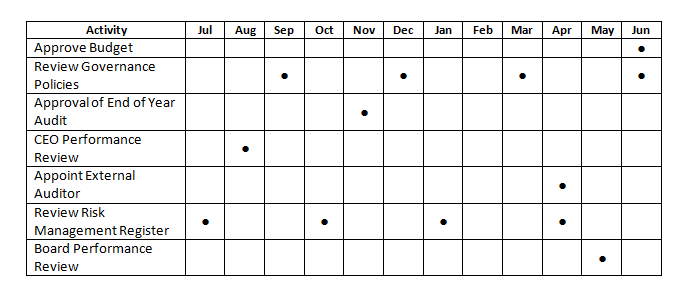When you prepare an agenda you will have items that are discussed at every meeting. These are your standard agenda items. There are also a number of items that may only need to be reported, reviewed or acted upon on a less regular basis. If you are Robin Hood you would always need to discuss plans to acquire and distribute funds. In your not for profit organisation, you may decide to review the strategic plan on a quarterly basis. The end of year audit only needs to be discussed and approved at one meeting and the approval of a budget usually occurs at just one meeting. . In addition, you may decide that over the year you will review all the governance policies, and on a quarterly basis you will review 25% of the policies.
The benefit of preparing an Agenda Timetable is that it makes it easier to schedule the relevant issues throughout the year so you avoid ending up with a backlog. The use of the timetable also informs board members when certain issues will be covered and it makes it easy to plan to meet deadlines. Some deadlines may be internal such as the approval of the budget and other deadlines may be statutory such as the submission of returns to ASIC.
A simple example of an Agenda Timetable is shown below with just a few activities to highlight the concept. (Click on the image to see the larger view)
It is important that the activities on the Agenda Timetable are related to your organisation and are board related. It is also good practice that at the end of each meeting the Agenda Timetable is reviewed to ensure the issues can be addressed in time.

 Posted on 21,Sep |
Posted on 21,Sep |
 Posted by Anne
Posted by Anne 





Comments
By The Key Elements of the Meeting Agenda
12 years ago
[...] [...]
By The Finance Subcommittee – Admin Bandit
12 years ago
[...] covered issues associated with preparing the agenda, the key elements of an agenda as well as the use of an agenda timetable to assist with scheduling relevant issues throughout the year. In the examples provided, issues [...]
By Preparing for the board meeting
12 years ago
[...] [...]